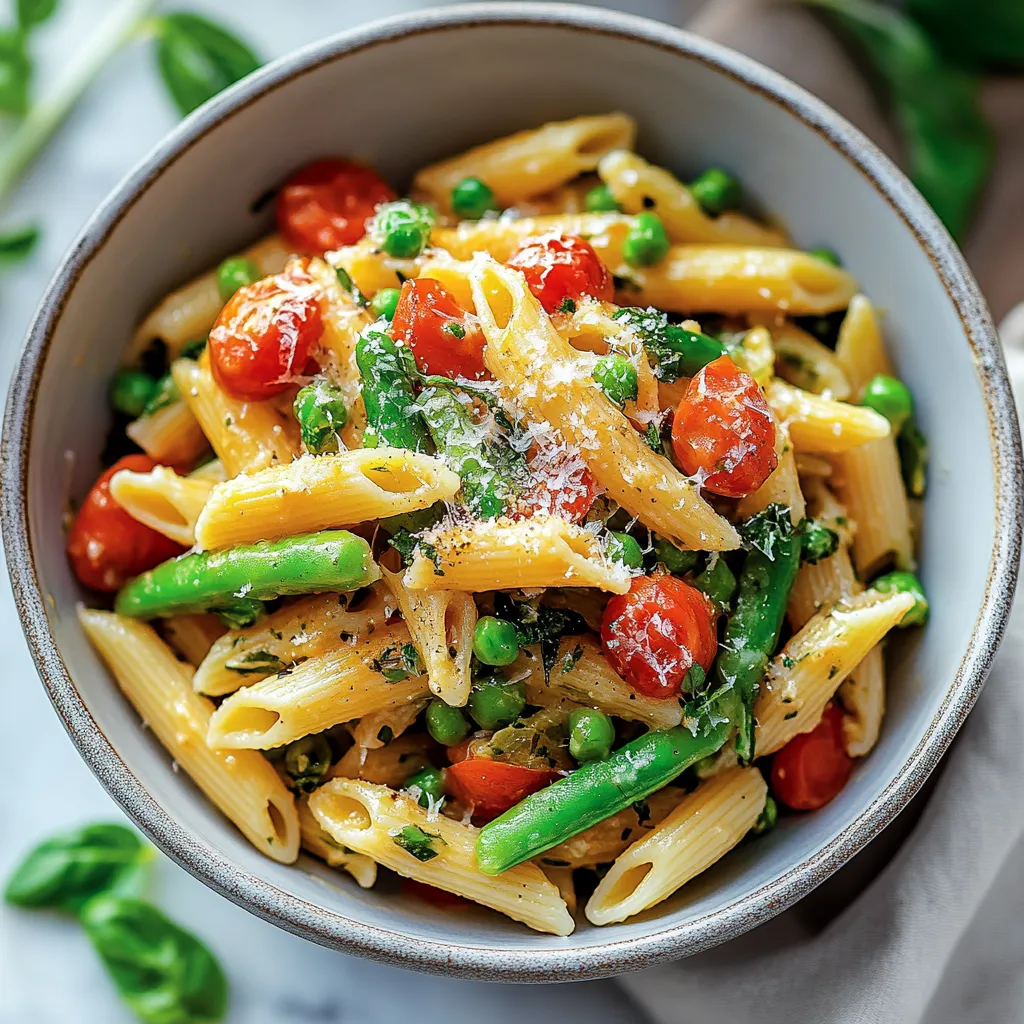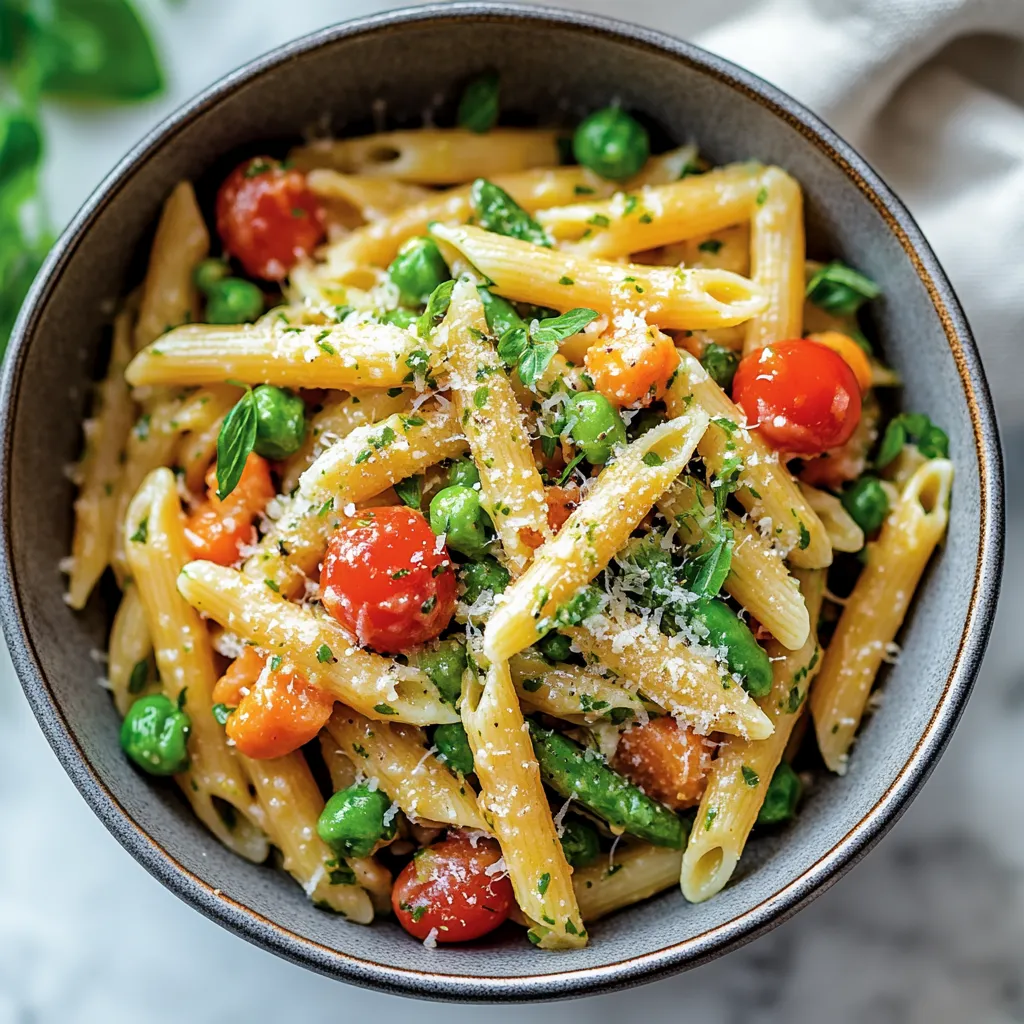 Pin
Pin
This vibrant spring vegetable pasta has become my go-to dinner for celebrating the season's bounty. The combination of tender-crisp asparagus, sweet peas, and juicy cherry tomatoes creates a light yet satisfying meal that brings all the freshness of spring to your table. I originally created this dish when my garden first started producing, and now it signals the official start of the warm season in our home.
I first made this pasta during an unseasonably warm April evening when I wanted something light but comforting. Now it appears on our table weekly through the entire spring and summer seasons, with variations depending on whatever looks freshest at the farmers market.
Ingredients
- Pasta: any short or long shape works, but I find penne perfectly captures the sauce in its ridges and hollow centers
- Asparagus: select bright green stalks with tightly closed tips for the freshest flavor
- Cherry tomatoes: adds juicy bursts of sweetness that complement the earthier vegetables
- Sugar snap peas or green peas: brings natural sweetness and a satisfying pop of texture
- Garlic: forms the aromatic foundation that ties all the vegetables together
- Red pepper flakes: optional but adds a gentle warming note that balances the fresh vegetables
- Fresh herbs: basil and parsley provide brightness and color that elevates the whole dish
- Lemon zest and juice: the acid adds a clean, vibrant finish that makes all the flavors sing
- Parmesan cheese: creates a light creamy coating for the pasta without heaviness
Step-by-Step Instructions
- Pasta Cooking:
- Cook your pasta in generously salted water until just al dente, usually a minute less than package directions suggest. The pasta will continue cooking slightly when tossed with the hot vegetables. Be sure to reserve some starchy pasta water before draining this is crucial for creating a silky sauce.
- Vegetable Preparation:
- Sauté garlic in a combination of olive oil and butter until fragrant but not browned, about 30 seconds. The butter adds richness while olive oil prevents burning. Add vegetables and cook just until brightened in color and slightly tender. The secret is maintaining some crispness for textural contrast.
- Creating The Sauce:
- Return the drained pasta to the pan with vegetables, adding reserved pasta water and Parmesan. The starchy water and cheese create a light emulsion that coats every piece perfectly. Add lemon juice and zest now for brightness that cuts through the richness.
- Finishing Touches:
- Remove from heat before adding delicate fresh herbs to preserve their vibrant color and aroma. Toss gently but thoroughly to distribute everything evenly. The residual heat will slightly wilt the herbs without destroying their flavor.

My favorite moment with this dish came during an impromptu dinner party when a friend claimed to dislike vegetables. After reluctantly trying this pasta, she not only cleaned her plate but asked for the recipe. The natural sweetness of spring vegetables, properly cooked, can convert even the most committed vegetable skeptics.
Seasonal Variations
This pasta framework works beautifully year round with seasonal adjustments. In summer, swap asparagus for zucchini and add fresh corn kernels. Fall calls for butternut squash cubes and sage instead of basil. Winter versions can incorporate hearty greens like kale and sun dried tomatoes when fresh aren't at their peak. The technique remains the same while the ingredients celebrate whatever is freshest at the moment.
Make It A Meal
While delicious on its own, this pasta pairs beautifully with simple proteins. Add grilled chicken, sautéed shrimp, or flaked salmon directly to the pasta for a complete one dish meal. For a vegetarian protein boost, white beans or fresh mozzarella pearls make excellent additions. I often serve it alongside a simple green salad with lemon vinaigrette and crusty bread for a complete Mediterranean inspired dinner.
Storage Solutions
This pasta keeps beautifully in the refrigerator for up to three days, making it perfect for meal prep. The flavors actually develop and meld overnight. When serving leftover portions cold, I recommend a fresh squeeze of lemon juice and additional herbs to brighten the flavors. If reheating, add a splash of water or broth and warm gently to prevent the pasta from drying out.
Common Questions About This Recipe
- → Can I use other vegetables in this dish?
Yes, you can substitute vegetables like zucchini, broccoli, or spinach for a variation on the recipe. Just make sure to adjust cooking times to maintain crispness.
- → What type of pasta works best?
You can use penne, linguine, farfalle, or any favorite pasta shape that holds the sauce and veggies well.
- → Can I make this dish vegan?
Absolutely! Replace the butter with more olive oil, omit the Parmesan cheese, and consider using nutritional yeast for a cheesy flavor.
- → How do I store leftovers?
Store the pasta in an airtight container in the refrigerator for up to 3 days. Enjoy it cold as a pasta salad or reheat gently.
- → What protein can I add to this dish?
Shredded chicken, grilled shrimp, or chickpeas are great options for adding protein to this dish.
